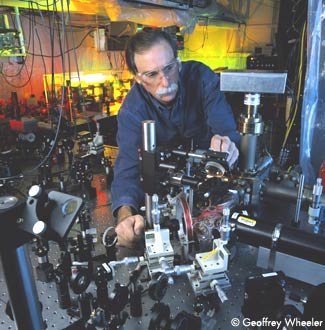
The pioneering atomic physicist David Wineland is one of eight US researchers to be awarded the 2007 National Medal of Science. Wineland, a physicist at the National Institute of Standards and Technology (NIST), was cited for his “outstanding leadership in developing the science of laser cooling and manipulation of ions”. He will receive the award from President George W Bush in a ceremony in Washington, D.C., on 29 September.
The National Medals, which are administered by the National Science Foundation (NSF) and awarded each year, were established by the US Congress in 1959 to honour scientific research that “enhances understanding of the world and leads to innovations and technologies that give the US a global economic edge”.
Based in Boulder, Colorado, Wineland is credited for his work on “applications in extremely precise measurements and standards, quantum computing, and fundamental tests of quantum mechanics, and for his major impact on the international scientific community through training scientists and outstanding publications.”
Helped isolate a single electron
Wineland’s long record of breakthroughs began in 1973, when as a postdoctoral researcher with Hans Dehmelt at the University of Washington he helped isolate a single electron using a Penning trap. Five years later, Wineland — by then in charge of his own group at NIST in Boulder — succeeded in laser cooling magnesium ions to below 40 K.
This early work on trapped ions was aimed at developing alternatives to the caesium beam clock, which then formed the basis of international time and frequency standards. However, the ion cooling and trapping techniques Wineland developed had a much wider impact, sparking work on neutral atom laser cooling, which formed the foundations of both the 1997 and 2001 Nobel Prizes.
Later, Wineland helped launch the field of experimental quantum computing by demonstrating the first two-bit “controlled-NOT” quantum logic gate. Recent work has focused on overcoming barriers to turning such few-qubit systems into a full-scale quantum computer.
“Wineland is an outstanding scientist who has made revolutionary contributions to the development and application of laser cooling and trapping,” said Katherine Gebbie, head of NIST’s Physics Laboratory. “We are thrilled by this well-deserved recognition for him”.
‘Invented ion trap quantum computing’
There was also praise from Winfried Hensinger, senior lecturer and head of the Ion Quantum Technology group at the University of Sussex in the UK. “Dave Wineland really invented ion trap quantum computing, which has been the most successful experimental method used to date,” he said. Hensinger described the award as “well overdue” and noted that Wineland “stands out in that he’s immersed in all the results that come out of his group – he always knows exactly what’s going on in the lab”.



